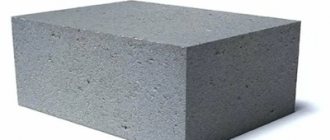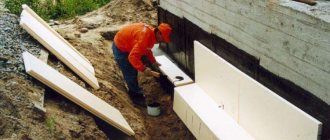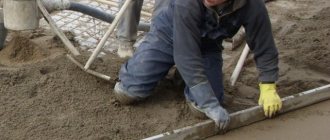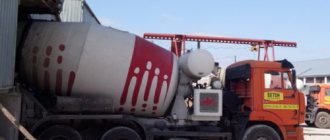The foundation of the building must be strong, the requirements for building materials are extremely high. They must resist physical and chemical attack from the environment.
Ready-made building mixtures are more often used, which saves effort and time and simplifies the work.
Sand concrete is resistant to loads, moisture, and temperature changes. In addition to high wear resistance, its advantage is its low specific gravity, which reduces the load of the building on the surface.
Sand concrete for foundation construction
The foundation of the building must be strong, the requirements for building materials are extremely high.
They must resist physical and chemical attack from the environment. Ready-made building mixtures are more often used, which saves effort and time and simplifies the work.
Sand concrete is resistant to loads, moisture, and temperature changes. In addition to high wear resistance, its advantage is its low specific gravity, which reduces the load of the building on the surface.
- Is it possible to use sand concrete for the foundation?
- Types of sand concrete
- Which sand concrete is better to choose?
- Mixing proportions of components
- Preparation of concrete
- Pouring concrete
- Disadvantages of sand concrete
- Sand concrete price
Flaws
Negative aspects of sand concrete:
- large amount of material consumption. Expenses for arranging the basement structure are increasing;
- low-quality fake raw materials that are difficult to distinguish. You need to require a quality certificate. Buy goods at points where the rules for their storage are ensured;
- inconvenient to transport due to packaging in paper bags. No need to buy 50 kg bags. They are heavy. They cannot withstand the weight and tear. Option - 25 kg bags.
Sand concrete is a construction raw material that is used to lay the foundation structure of a house. Used for pouring monolithic concrete slabs and strip-type structures. Used as a mortar for making a block base. It is recommended to buy high-quality building materials. Don't save money. Cheap raw materials will not meet the high technical parameters that the foundation must have. Proportions must be observed.
Average score of ratings is more than 0
Share link
Comments There are no comments yet, but you could be the first...
Areas of use of building materials
Sand concrete compositions of different brands are used in construction to solve the following problems:
- sealing cavities and cracks in the base of the floor and walls;
- arrangement of inclined and horizontal screeds;
- erection of building walls from aerated concrete, brick, gas silicate and other building blocks;
- concreting the foundations of structures;
- production of monolithic reinforced concrete products;
- construction of foundations and leveling of the subfloor;
- production of decorative tiles for walkways.
Which brand of sand concrete is better?
The sand concrete mixture has the following typical composition:
- 60% sand or screenings;
- 30% Portland cement;
- 10% specialized additives (plasticizers, frost-resistant, etc.).
This material is marked with the letter “M” and the numbers 100, 200, 300, 400 and 500. The digital code indicates the load that ready-made concrete can withstand per 1 cm2. The most common brand for construction is M300. All thanks to a large list of advantages:
- resistance to mechanical damage, as well as static and vibration loads;
- fire safety;
- anti-corrosion properties;
- concrete does not emit harmful substances, that is, it is chemically neutral;
- increased adhesion with most popular materials (metal, wood, etc.);
- absence of large shrinkage;
- does not pollute the environment.
Also, M300 sand concrete is a self-leveling mixture and forms a smooth surface. This material is very easy to use, which means it saves physical and financial resources.
The information in the following video will help you easily choose high-quality sand concrete.
Proportions
The components of the mixture harden quickly. The finished composition is characterized by a sand to cement ratio of 2:1. Additionally, plasticizers are used to allow the solution to be used in the external environment in winter. To mix 10 kg of dry cement, you need to prepare 2 liters of water.
The difference between sand concrete mortar is that crushed stone is not used. It is replaced by sand, large grains of sand.
For the construction of a basement floor with a total area of 100 sq. m., you will need 20 thousand kg of cement (140 bags). For 1 sq. m. you will need 200 kg of building materials.
Description and properties of the material
In everyday life, sand concrete is the name given to dry concrete mixtures of fine-grained and coarse-grained fractions (BSM) . The smaller the filler, the higher the plasticity of the mixture, the easier the installation. The complex mixture ensures that the formwork is filled without voids and gas formation is reduced.
Product Features:
- the strength of finished products depends on the brand of cement;
- The degree of shrinkage is controlled by the amount of sand fraction.
Structural elements made of sand concrete can withstand frost and show the standard strength for each specific group. Dry concrete mixtures are more expensive compared to standard mixtures, but builders prefer them. Among the components there are setting accelerators, additives for resistance to chemicals, and insolation.
Composition and characteristics
The components are dosed at the factory with step-by-step control and precise weighing. Manufacturers use the same raw materials and adhere to standard technology.
The dry mixture includes :
- binder - high-quality Portland cement;
- filler - coarse river sand;
- modifying additives.
Changing the required ratio leads to a decrease in quality.
Main characteristics of sand concrete for screed, plaster and masonry mortar:
- grey colour;
- adding water per 1 kg -0.15 - 0.18 l;
- movement of the solution and readiness for use - 48 hours;
- compressive strength at the end of strength development (28 days) - 30 MPa;
- tensile strength from the surface - 0.5 MPa;
- withstands 50 series of freezing and thawing;
- volumetric weight 2000 – 2300 kg/m³.
There are materials containing fiber and microfibers for creating reinforcing screeds.
Types of sand concrete
Three types of sand concrete are distinguished depending on the size of the filler: fine fraction - size ≤ 1.2 mm, medium fraction - ≤ 2.5 mm, coarse fraction - 3 - 4 mm. Sand concrete is produced in the following grades: M100, M150, M200, M250, M300, M400, M500.
Description of common types according to GOST 74.73 - 1994 :
- BSM V7.5 P2. Used for plaster, strength 98 – 100 kg/cm², resistance to water absorption W4, sand fraction 0.8 – 1.2 mm;
- BSM V7.10 P2 . Used in repair work of external walls, when installing floor screeds, for laying bricks and rubble. Strength - 150 - 160 kg/m², quartz and sand filler fraction 0.8 - 2.0 mm.
Brands BSM V7.25 P2 and BSM V7.35 P2 belong to the high-strength categories. Such compositions are suitable for the construction of load-bearing structures, supports, columns, and beams. Universal grades provide good adhesion to subsequent finishing.
Application area
Sand concrete with coarse filler is characterized by increased strength, so supporting structures and parts are made from it. They make monolithic reinforced concrete purlins, floor slabs, coverings, and build powerful foundations.
How to prepare concrete solution
Due to the fact that the dry mixture contains all the necessary components, and the instructions indicate in what proportion to add water, using sand concrete is easy and convenient. The materials are loaded into a running mixer simultaneously and mixed for 1-2 minutes. In private construction, when using a mixer, the solution is mixed until smooth.
In winter, the solution can be mixed with warm water. In this case, water at a temperature not exceeding 70°C is used.
For winter work, it is necessary to use complex antifreeze additives, which accelerate the strength gain of concrete and prevent the destruction of concrete structures.
Is sand concrete suitable for foundations?
The advantages of this building material are difficult to overestimate. It is resistant to negative temperatures and corrosion processes. The characteristics show that this product is resistant to moisture. Finally, low cost is also an undeniable advantage over other types of concrete.
The foundation can be strip (monolithic), prefabricated (in this case, ready-made sand concrete blocks are used) and mixed type (both methods are combined here). When constructing all these structures, you can work with the above material. It can be used as a base and also as a link. In the latter case, the solution can complement ready-made foundation blocks. It is enough to fill the gaps between the individual parts to give the building maximum strength.
Is it possible to use sand concrete for the base?
The positive aspects of sand concrete are difficult to overestimate. Characterized by low temperature resistance. Does not corrode. Not afraid of high levels of humidity, affordable.
Allowed to be used for the construction of strip and prefabricated foundations. It is used for a combined design that combines both types at the same time. Sand concrete is used as the main building material. Used as a connecting link. The solution is supplemented with ready-made block elements. The gaps between the individual parts of the foundation are filled. The result is a reliable design. Almost a monolith.
Pouring concrete
It is recommended to use the cement mortar within 2 hours after mixing. The raw material hardens quickly. After this time, it cannot be used. It is not advisable to add water and dilute the solution. It will not be possible to maintain exact proportions. The result will be low-quality building material. Possible destruction of the base structure. Reinforcement is required.
During work, it is necessary to ensure that air bubbles are removed from the concrete cavity. The surface is constantly pierced with a metal rod.
The concrete screed will dry in 24 hours. On the second day, they begin to dismantle the wooden formwork. A technical break is taken for a month. The foundation must gain strength, then you will get a high-quality concrete foundation. Otherwise, the consequences will be irreparable.
Preparation of concrete
It is recommended to prepare the concrete solution with water at room temperature, no more than 20 degrees Celsius above zero.
Kneading
Step-by-step instructions for preparing the cement composition:
- The required volume of water is poured into the container. Gradually add the dry mixture, while simultaneously mixing the solution with a drill and a mixer attachment.
- When a homogeneous mass is reached, without lumps, stop working. A break is taken for 10 minutes. The composition must be infused.
- Mix everything again.
It is allowed to prepare and work with sand concrete mortar at temperatures with a plus of 5-30 degrees Celsius. If it is impossible to maintain such a regime, it is better to use compounds with plasticizers. They are added separately to the finished mixture. Proportions must be observed. Do not deviate from the instructions.
Subject to compliance with construction GOSTs and instructions for creating the solution, the operational and technical characteristics of the resulting composition will not differ from the finished purchased analogue.
What is the composition
Classically, the dry sand concrete mixture presented on the modern market is formed from 3 main components. This is, first of all, Portland cement, plus sand of various fractions acts as a filler. Various types of additives are also necessarily present, the composition of which is determined depending on the purpose and operating conditions of the poured mass.
Important: now the quality of this material is regulated by GOST 7473-94. The marking indicates, first of all, the rate of hardening; it can also be used to determine which fraction of sand was used in the filler. Grades from M150 to M500 are produced; the most popular in this line in terms of price/quality ratio is the M300 sand concrete grade.
Mixing the composition with a mixing attachment.
How much will it cost if you buy a ready-made one at the factory?
I prepared a cubic meter of concrete using my concrete mixer in about half a day. Plus work with a shovel, carrying bags of cement of 50 kg each, carrying water from a barrel.
If I were 20 years younger, I would just enjoy it. But at my age, I decided to be careful and still order a mixer from a concrete plant.
Concrete grade M400 at the plant costs about 3,500 rubles per cubic meter.
Concrete cost table.
Since my site is located 50 km from the nearest concrete plant, delivery of a mixer with 6 cubic meters of concrete cost me 20,000 rubles. Plus an additional payment of 500 rubles for long unloading.
It is not so easy to move concrete over wooden formwork, and it took the two of us to unload the mixer for about two hours. In total, a cubic meter of concrete cost me about 8,000 rubles, excluding the assistant’s salary.
Sand concrete price
The cost of building materials depends on the composition, brand, brand and store markup. It can be in the range:
| Package weight in kg | Price in rubles |
| 25 | 50-230 |
| 40 | 80-400 |
| 50 | 190-600 |
Wholesale purchasing from the manufacturer saves money by an average of 20-30 percent.
A sand concrete base will be more expensive than a cement-sand base. But the costs are offset by the strength of the finished structure and resistance to cracking.
Subtleties of screed arrangement
As mentioned earlier, most often the mixture is used for pouring concrete screed in premises for various purposes, so we will talk about the characteristics of the mixture, based specifically on this direction.
Preparation and marking
Often the screed is installed on a ready-made concrete base. As a rule, these are reinforced concrete floor slabs or rough concrete screed.
The base must be pre-prepared, the debris must be removed, and loose layers should preferably be knocked down.
Working with a hydraulic level.
Advice: if the base has significant differences in height, then we recommend pre-leveling them with concrete grade M200 - M300. Since in this case the consumption of sand concrete per 1 m2 will be excessively high and the cost of pouring will be high.
- After cleaning, you need to apply 2 layers of deep penetration primer to the base; it is advisable to use primer with waterproofing characteristics. When the soil is dry, the perimeter of the room, as well as all joints and cracks, must be coated with sealing mastic; this is especially important for multi-story buildings. A compensation damper tape is installed around the perimeter.
- It is most convenient to do markings using a laser level, but if you don’t have one, then you can easily get by with a liquid level that works like communicating vessels.
- The laser level will immediately highlight the desired horizon; if the horizon is reflected at the liquid level, then first it is better to draw a horizontal line at a height convenient for your height. After this, using a ruler and tape measure, the horizontal line is lowered to the desired level.
Reinforcement with metal mesh.
How much mixture will you need?
When the average thickness of the pour is known, it will be useful to calculate the sand concrete, but experts recommend that even if it seems to you that all the calculations are correct, it is better to take the material with a margin of about 10%.
- Naturally, each company producing this mixture has its own instructions, but on average, the consumption of sand concrete per 1 m2 is approximately 20 kg with a pouring thickness of 1 cm. From here, through simple arithmetic operations, the total amount of material can be deduced.
Important: if we are talking about the foundation, then it is better to know how many bags of sand concrete there are in a cube. Packaging can be in bags from 20 to 100 kg, but it is important to remember that pouring 1 m³ of solution will require about 750 kg of dry mixture.
- Also, when making calculations, it should be taken into account that the minimum thickness of the screed at the highest point of the base should not be less than 7 mm.











